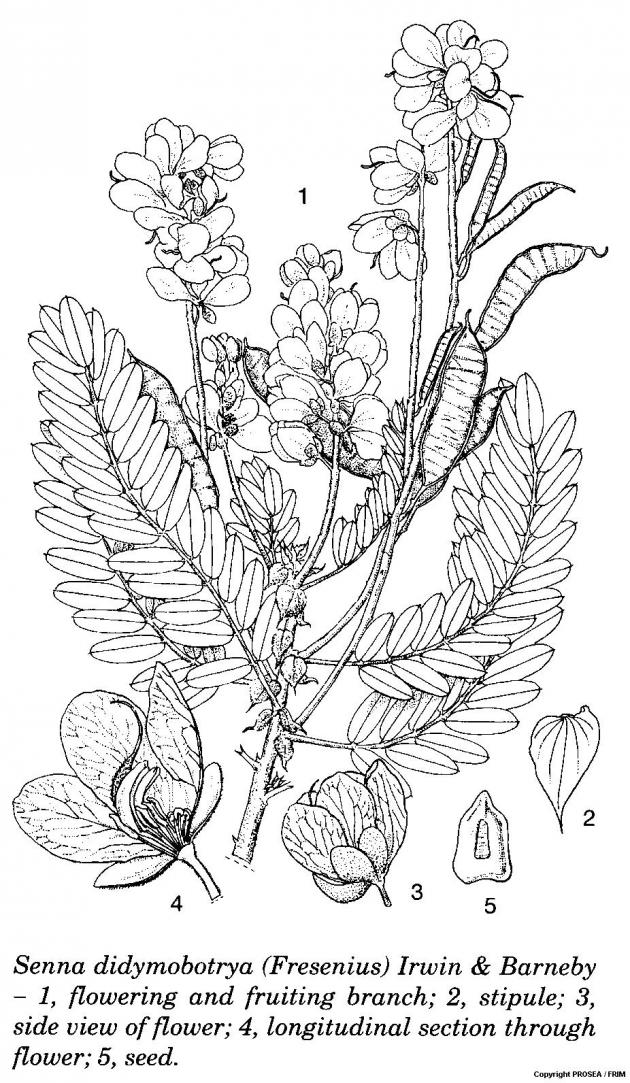Scientific Name
Senna didymobotrya (Fresen.) H.S.Irwin & Barneby
Synonyms
Cassia didymobotrya Fresen., Cassia nairobensis Hort. ex L. H. Bailey, Cassia nairobiensis L.H.Bailey, Cassia verdickii De Wild. [1]
Vernacular Name
| English | Candelabra tree, wild senna [2] |
| India | At tora, rata tora [3] |
| Japan | Futa-ho-senna [3] |
| Congo | Kashege, mchanzoka, muchora, mukangabazimu, umubagabaga, umucyuro, umuyoka [3] |
| Kenya | Ithaa, libinubinu, owino, senetoi, senetwet [3] |
| Tanzania | Ifeno, ivinu, mukyala, omukyola, ormapinu, qarere [3] |
| Rwanda | Umubagabaga, umucuru, umucyurabuhora, umucyure, umucyuro [3] |
| Uganda | Lakera, mucora, mugabagaba, mukora, muvuvumila, njaga, omucuula, omugabagabac [3] |
| Southern Africa | Munwahuku, utupa [3] |
| United States of America | African wild sensitive plant [2]. |
Geographical Distributions
Senna didymobotrya is native to tropical East and Central Africa, from Ethiopia and Sudan to Angola and Mozambique. It was introduced into tropical Asia and America as a green manure and cover crop, and later as an ornament. It is sporadically naturalised in frostless regions, including Malesia. It is now grown throughout the world as an ornament. [2] In its natural habitat, S. didymobotrya is often ruderal in riparian montane wooded grasslands or evergreen bushlands, at 900-2400 m altitude. It tolerates light frost. [2]
Botanical Description
S. didymobotrya is a member of the family Leguminosae. It is usually a several-stemmed shrub or small tree that reaches about 0.5-5(-9) m tall. The branches are cylindrical, striate, pubescent to villous and rarely nearly smooth. [2]
The leaves are simply paripinnate, narrowly oblong-elliptical in outline and measuring 10-50 cm long. The stipules are broadly ovate-cordate, measuring 6-17 mm x 8-10 mm, acuminate, palmately veined, reflexed and tardily caducous. The cylindrical petiole is 1-8 cm long while the rachis is up to 40 cm long. They are both pubescent and eglandular. The petiolules are up to 3 mm long. There are 8-18 of leaflets, which are chartaceous, elliptical-oblong, measuring 2-6.5 cm x 0.5-2.5 cm, 2-3 times longer than width, with oblique base, rounded but mucronate at apex, pubescent to glabrescent and with distinct marginal veins. [2]
The inflorescence is an erect, axillary, 20-30-flowered and spike-like raceme which is 10-50 cm long. The peduncle is cylindrical, measuring 5-8 cm long and pubescent. The bracts are broadly ovate, measuring 8-27 mm x 5-15 mm, black-green and are at first imbricated and enclosing the flower buds. The bracteoles are absent. The slender pedicel is 3-10 mm long and densely pubescent. The 5 subequal sepals are oblong-obovate, measuring 9-14 mm long, minutely hairy and green while the 5 petals are slightly unequal, at first incurved but later on becoming more spreading, ovate to obovate, measuring 17-27 mm x 10-16 mm, with a slender claw about 1 mm long, hairless, bright yellow and delicately veined. There are 10 stamens. The filaments are shorter than the anthers. The anthers of 2 lower stamens are 9-11 mm long. The 3 upper stamens are staminodial while the anthers of 5 median stamens are about 5 mm long. The ovary and stipe are velvety pubescent. The style is slender, hairless, recurved and measuring about 1 cm long. The stigma is punctiform. [2]
The fruit is a flat, 9-16-seeded pod, which is linear-oblong, measuring 7-12 cm x 1.5-2.5 cm, glabrescent, short-beaked, dehiscent or indehiscent when dry, depressed between the seeds, with raised sutures and blackish-brown. The smooth, pale brown and flattened seed is oblongoid, apiculate and measuring 8-9 mm x 4-5 mm x 2.5 mm. The elliptical areole measures 3-4 mm x 0.7-1.5 mm. [2]
Cultivation
No documentation
Chemical Constituent
No documentation
Plant Part Used
No documentation
Traditional Use
No documentation
Preclinical Data
No documentation
Clinical Data
No documentation
Poisonous Management
No documentation
Line Drawing

References
- The Plant List. Ver 1.1. Senna didymobotrya (Fresen.) H.S.Irwin & Barneby. [homepage on the Internet]. c2013. [updated 2010 Jul 14; cited 2015 Aug 14]. Available from: http://www.theplantlist.org/tpl1.1/record/ild-1013
- Sunarno B. In: Faridah Hanum I, van der Maesen LJG, editors. Plant Resources of South-East Asia No. 11: Auxiliary plants. Leiden, Netherlands: Backhuys Publisher, 1997; p. 229-231.
- Quattrocchi U. CRC world dictionary of medicinal and poisonous plants: Common names, scientific names, eponyms, synonyms, and etymology. Volume V R-Z. Boca Raton, Florida: CRC Press; 2012. p. 240.


